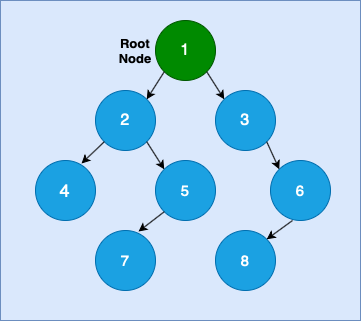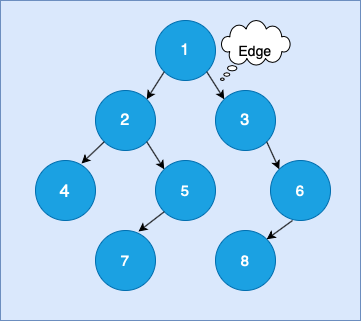Introduction to Tree Data Structure
Tree Data Structure is a non-linear or hierarchical data structure. In terms of graph, tree data structure can be defined as a special type of graph data structure with no circuits in it.

Basic Terminologies of Tree Data Structure:
Root Node: Root Node is a first node in a tree from where tree originates. In any tree there is exactly one root node. In the following diagram, ‘1’ is a root node.

Edge: Edge is basically referred as connector between any two nodes of the tree. In a tree with ‘n’ number of nodes, there will always be exactly (n-1) number of edges.

Parent Node: A Parent Node is a node which has a directed branch from it to any other node. In general tree, parent node can have multiple children.

In the following diagram,
Node 1 is a parent node of Node 2 and Node 3.
Node 2 is a parent node of Node 4 and Node 5.
Node 3 is a parent node of Node 6.
Node 5 is a parent node of Node 7.
Node 6 is a parent node of Node 8.
Child Node: The Node which is descendant of some node is called Child Node. All the nodes in a tree except root node are child node. In general tree, a parent node can have multiple child nodes. In case of binary tree, which is special type of general tree, a parent node can have at most two child nodes.

In the following diagram,
Node 2 and Node 3 are child Nodes of Node 1.
Node 4 and Node 5 are child Nodes of Node 2.
Node 6 is a child Node of Node 3.
Node 7 is a child Node of Node 5.
Node 8 is a child Node of Node 6.
Leaf Node: Leaf Node is a type of node in a tree which does not have any child nodes. In the following diagram, Node 4, Node 7 and Node 8 are Leaf Nodes of the Tree.

Sibling Nodes: Two nodes are known as sibling nodes of each other if they are directed from same parent node. In other words, sibling nodes have same ancestors.

Internal Node: Internal Nodes are those nodes which have at least one child node. In other words, internal nodes are non-leaf nodes. In the following diagram, Node 1, 2, 3, 5, 6 are internal nodes.

Path: In a tree, the sequence of nodes and edges from one node to any other node is known as path. In the following diagram, the path from Node 1 to Node 7 is highlighted.

Degree of Node: Degree of node is defined as total number of immediate children of the node. In case of binary tree, the highest degree of any node is 2.

In the following diagram,
The degree of Node 1 is 2.
The degree of Node 2 is 2.
The degree of Node 3 is 1.
The degree of Node 4 is 0.
The degree of Node 5 is 1.
The degree of Node 6 is 1.
The degree of Node 7 is 0.
The degree of Node 8 is 0.
Height/Depth of the Tree: The height of the tree is defined as total number of nodes in a longest path from root node to any leaf node. In the following diagram, the height of the tree is 4.

Level: The Level of the tree is defined as each step from root to bottom node(leaf) of the tree. The root node is present at level 0.

Related Posts:
- Binary Tree Traversals
- Print All Leaf Nodes of a Binary Tree
- Count Number of Nodes in a Binary Tree
- Print Alternate Levels of Binary Tree
- Maximum Width of Binary Tree
- Level Order Tree Traversal
- Left View of Binary Tree
- Right View of Binary Tree
- Compute Height of Binary Tree
- Inorder Tree Traversal Using Stack
- Preorder Tree Trasversal Using Stack
- Postorder Tree Traversal Using Stack
- Vertical Order Tree Traversal
- Top View of Binary Tree
- Bottom View of Binary Tree
- Delete Complete Binary Tree
- Check if two trees are mirror Trees of Each Other
- Convert Binary Tree to its Mirror Tree
- Check if Binary Tree is Symmetric or Not
- Print All Root to Leaf Paths in a Binary Tree